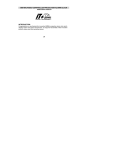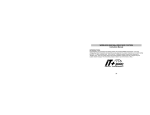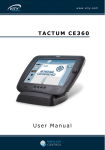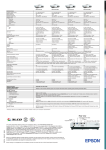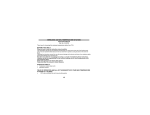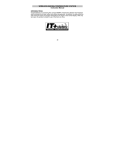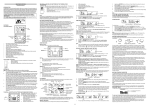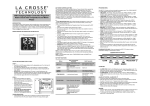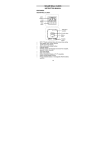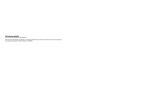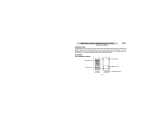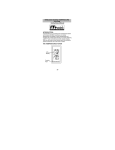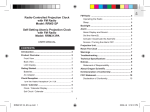Download User manual
Transcript
RADIO CONTROLLED PROJECTION ALARM CLOCK Instruction manual INTRODUCTION: Congratulations on purchasing this Projection clock with DCF-77 radio-controlled time. The operation of this product is simple and straightforward and by reading this operating manual, users will receive the optimum benefits of all its features. 30 Battery compartment LCD Display Function keys Stand Adapter socket FEATURES • DCF-77 Radio controlled time with manual setting option • Time projection (hour and minute) • LED back-light • Indoor temperature displayed in degree Celcius • Calendar display • Alarm setting with snooze function • Time zone (± 9 hours) 31 SETTING UP : The projection clock can be batteries operated or powered by the provided AC/DC adapter. POWER SUPPLY : The Projection Clock uses 2 x AA, IEC LR6, 1.5V batteries. To install and replace the batteries, please follow the steps below: 1. 2. 3. Lift up and remove the battery compartment cover. Insert batteries observing the correct polarity (see marking). Replace compartment cover. Note: User shall also refer to Manual Setting for detailed Setting up procedures. 32 In addition or instead of inserting batteries, the AC adapter can be used: 1. Connect the power adapter to a wall socket 2. Insert the adapter into the jack at the bottom of the clock 3. The Projection clock will now start receiving the DCF time signal. After approximate 3 to 5 minutes, the DCF time will be displayed Note: User shall also refer to Manual Setting for detailed Setting up procedures. 33 Important! Use only the adapter provided with the projection clock and make sure that your household voltage is appropriate to the working voltage of the transformer. Otherwise your projection clock may be damaged. • Radio controlled time receiver is at the bottom side of the main unit. Don’t place the adapter wire adjacent to the bottom side of the main unit when AC power is used, as this may decrease the reception sensitivity. 34 BATTERIES POWERED WITH THE USE OF AC/DC ADAPTER If the Projection clock is first powered by batteries and the power adapter is subsequently used for extended period of time, the main power source of the Projection clock will switch to AC/DC power. The batteries will then act as a backup power source in case of power failure. Notes: • After the projection clock is powered, there will be a beep sound and the LCD (Liquid Crystal Display) will activate. • The indoor temperature and the time as 0 :00 will be displayed. • The DCF time reception will automatically be initiated, and a tower icon will appear (no tower icon will appear if the time reception is too weak to be detected, and the time display will start from 0:00). • When DCF time has not been received, user may use the MODE/MIN key to manually enter a time and date initially. The clock will automatically attempt to receive the DCF time at each full hour. When this is successful, the received time will override the manually set time. The date is also updated with the received 35 time. (Please refer also to notes on “DCF-77 radio controlled time” and “Manual time setting”). TO RESET THE PROJECTION CLOCK To reset the Projection clock to the factory default setting or in case of a malfunction, please remove all batteries from the unit and unplug the AC/DC adapter from any power source. Wait at least for 3 minutes before powering up the Projection clock again. BATTERY CHANGE: It is recommended to replace the batteries in all units regularly to ensure optimum accuracy of these units. (Battery life –see Specifications) Please participate in the preservation of the environment. Return used batteries to an authorized depot. 36 RADIO CONTROLLED TIME The time base for the radio controlled time is a Cesium Atomic Clock operated by the Physikalisch Technische Bundesanstalt Braunschweig which has a time deviation of less than one second in one million years. The time is coded and transmitted from Mainflingen near Frankfurt via frequency signal DCF-77 (77.5 kHz) and has a transmitting range of approximately 1,500 km. Your radio-controlled Projection clock receives this signal and converts it to show the precise time in summer or wintertime. The quality of the reception depends greatly on the geographic location. In normal cases, there should be no reception problems within a 1500km radius of Frankfurt. The DCF tower icon in the clock display will start flashing in the upper center. This indicates that the clock has detected that there is a radio signal present and is trying to receive it. When the time code is received, the DCF tower becomes permanently lit and the time will be displayed. If the tower icon flashes, but does not set the time or the DCF tower does not appear at all, then please take note of the following: 37 • Recommended distance to any interfering sources like computer monitors or TV sets is a minimum of 1.5 - 2 meters. • Within ferro-concrete rooms (basements, superstructures), the received signal is naturally weakened. In extreme cases, please place the unit close to a window and/ or point its front or back towards the Frankfurt transmitter. During nighttime, the atmospheric disturbances are usually less severe and reception is possible in most cases. A single daily reception is adequate to keep the accuracy deviation below 1 second. FUNCTION KEYS The radio-controlled Projection clock uses the following keys : SNOOZE button 38 MODE/ MIN button AL / HOUR button Projection Direction button SNOOZE : • Activate or deactivate snooze function • Alarm snooze function • Activate the projection of time • Exit the setting modes • Back light on 39 AL/HOUR : • Set the hours and day • Activate or desactivate alarm • Enter alarm setting mode • Stop alarm and snooze function • Back light on MODE/MIN : • Enter manual time setting mode • Set the minutes, weekday and month • Enter time zone • Stop alarm and snooze function • Back light on • PROJECTION DIRECTION : Project the image direction (can display 4 different orientations) 40 • Back light on MANUAL SETTING Time zone setting User shall first remove all the batteries from the projection clock and wait for 3 minutes. Then user shall press and hold the MODE/MIN key and at the same time place the batteries into the clock. Then there will be a beep sound and the flashing time zone digits "0 h" will be displayed. User may now press shortly the MODE/MIN key to set the time zone between +9 and -9 hours (The time zone default of the Projection clock is “0 hour”). flashing 41 Then confirm with the SNOOZE key and enter the Manual time setting. Note: If AC adaptor is used instead of battery, user shall first connect the adaptor to the wall socket, then press and hold the MODE/MIN key and finally insert the power cable to the jack of the clock. User shall keep on holding the MODE/MIN key until the time zone flashing digit "0h" is displayed on LCD. Then he may go on the manual setting. Manual time setting In case the Projection clock cannot detect the DCF-signal (for example due to disturbances, transmitting distance, etc.), the time can be manually set. The clock will then work as a normal Quartz clock. Hour flashing Minutes flashing 42 1. The hour and the minute digits will start flashing. 2. Use the AL/HOUR key to set the hour; MODE/MIN key to set the minute. 3. Confirm with the SNOOZE key and enter the Calendar setting. Note: • The unit will still try and receive the signal every one hour despite it being manually set. When it does receive the signal, it will change the manually set time into the received time. Also the manually-set date and weekday will be changed to the received date. • The time is displayed in 24-hour format. CALENDAR SETTING : The date default of the Projection clock is 1. 1. in the year 2005. Once the radiocontrolled time signals are received, the date is automatically updated. However, if the signals are not received, the date can also be set manually. 1. The year digits start flashing. Use the MODE/MIN key to set the year (the range runs from 2000 to 2049). 43 flashing 2. 3. Press the MODE/MIN key to set the year (between year 2000-2049). Press the SNOOZE key again to confirm and to enter the month and day setting. The month and day digits will start flashing. Day (flashing) Month (flashing) 44 4. 5. Press the AL/HOUR key to set the day and MODE/MIN key to set the month. Press the SNOOZE key again to confirm and to enter the Weekday setting mode. The weekday digit starts flashing. Weekday (flashing) 6. 7. Use the MODE/MIN key to set the weekday (Mo, Tu, We, Th, Fr, Sa or Su). Confirm all calendar settings with the SNOOZE key and return to the normal display. Important: If you want to change the setting again after the manual setting is completed, you have to uninstall all the batteries and repeat all the above-mentioned steps. On the other hand, if you just want to change the time zone, you may press and hold the MODE/MIN key for about 3 seconds to advance to the "Time zone setting" mode and then press shortly the MODE/MIN key to do the change. 45 ALARM SETTING : 1. Press and hold “AL/HOUR” button for about 3 seconds until the alarm time is flashing. Alarm-on icon flashing 46 2. 3. Press and release “AL/HOUR” to advance the hour, and “MODE/MIN” to advance the minute. The time will display in 24-hour format. Press the SNOOZE key to confirm. The alarm is now set and activated. TO ACTIVATE / DEACTIVATE THE ALAM : 1. After entering the alarm setting mode, the alarm is activated. 2. To toggle between activating and deactivating the alarm, briefly press the “AL/HOUR” key. Alarm-on icon, “(((•)))” will be displayed under the time display when the alarm is activated. SNOOZE SETTING : 1. While the alarm is sounding, press and release the SNOOZE bar to disable the alarm for 5 minutes. (After the SNOOZE bar is pressed, the alarm icon will keep flashing. After 5 min, the alarm will sound again.) 2. To desable the alarm, press and release the AL/HOUR or MODE/MIN button. 47 Note: The alarm duration is about 80 seconds. PROJECTION OF TIME Note: The projection is a red light, not harmful under normal usage, yet care should be taken to avoid looking directly into the light. 1. 2. 3. When the radio-controlled projection clock is plugged with an AC/DC adaptater, the clock will continuously be projected If the radio-controlled projection clock is only working with batteries, the time will be only projected when the SNOOZE key will be pressed The projection will auto-focus for display from about 1.7 to 2.0 meter away. A dark surrounding will be necessary to clearly see the projection. 48 The direction of the display can also be rotated 360° in 90° rotations by pressing the button. The projector case can be rotated 180° to further help Projection Direction orient the projected display. TOGGLE BETWEEN THE DISPLAY OF INDOOR TEMPERATURE, PRESET ALARM TIME AND CALENDAR : By pressing shortly the MODE/MIN key, you can toggle between the following displays: 1. Indoor temperature (°C) 2. Second of time 3. Preset alarm time 4. Day and weekday 49 BACK-LIGHT 1. The projection alarm has an LED backlight designed for night-viewing. This will light up for about 5 seconds whenever the SNOOZE button is pressed. 2. The LED backlight cannot be turned on constantly; this would drain the batteries. MAINTENANCE: • Avoid placing the alarm clock in areas prone to vibration and shock as this may damage and inaccurate readings. • Avoid exposure to sudden changes in temperature such as direct sunlight, extreme cold and wet or moist conditions. • When cleaning the display and casing, only use a soft damp cloth. Do not use solvents or souring agents as they may mark the LCD and casing. • Do not submerge the alarm clock in water. • Do not attempt to make any repairs to the alarm clock. Return it to its original point of purchase for repair by a qualified engineer. Opening and tampering with the unit may invalidate its guarantee. 50 SPECIFICATIONS: Temperature measuring range: Indoor : 0ºC to +49.9ºC with 0.1°C resolution (“OF.L” displayed if outside this range) Indoor temperature checking intervals : Every 10 seconds Power consumption: Battery : 2 x AA, IEC LR6, 1.5V (alkaline batteries recommended) Or AC adapter (included) : INPUT 230V AC 50Hz; OUTPUT: DC 3.4V (use the provided AC/DC adapter only) Battery life: Dimensions (L x W x H): Approximately 12 months 140.3 x 48.5 x 90.6 mm 51 LIABILITY DISCLAIMER • The electrical and electronic wastes contain hazardous substances. Disposal of electronic waste in wild country and/or in unauthorized grounds strongly damages the environment. • Please contact your local or/and regional authorities to retrieve the addresses of legal dumping grounds with selective collection. • All electronic instruments must from now on be recycled. User shall take an active part in the reuse, recycling and recovery of the electrical and electronic waste. • The unrestricted disposal of electronic waste may do harm on public health and the quality of environment. • As stated on the gift box and labeled on the product, reading the “User manual” is highly recommended for the benefit of the user. This product must however not be thrown in general rubbish collection points. 52 • • • • • • The manufacturer and supplier cannot accept any responsibility for any incorrect readings and any consequences that occur should an inaccurate reading take place. This product is designed for use in the home only as indication of the temperature. This product is not to be used for medical purposes or for public information. The specifications of this product may change without prior notice. This product is not a toy. Keep out of the reach of children. No part of this manual may be reproduced without written authorization of the manufacturer. R&TTE DIRECTIVE 1999/5/EC To be used in EC Member and EFTA States 53 Summary of the Declaration of Conformity : We hereby declare that this wireless transmission device does comply with the essential requirements of R&TTE Directive 1999/5/EC. 54





























